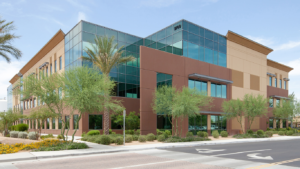The U.S. restaurant industry and the real estate it occupies are being reshaped by fundamental industry shifts including the rapid growth of third-party, meal-delivery services, increasing adoption of in-store automation, and the ongoing proliferation of fast-casual concepts, according to a new report from CBRE.
CBRE’s report highlights eight trends, also including the spread of small-format, “eatertainment” concepts, to examine their impact on the food-and-beverage sector and its real estate. Restaurants now account for 17 percent of U.S. retail sales, more than any other retail sector, and restaurant sales growth has outpaced overall U.S. retail sales gains in recent years.
“In today’s ever-evolving retail landscape, it’s more important than ever that retail center owners invest in restaurants that lend well to the center’s environment and its clientele,” said Carol Schillne of CBRE in Phoenix. “It’s no longer just about creating a beautiful restaurant space, it’s about creating a space that brings the right kind of energy to the center and keeps customers around long after they’ve finished their shopping.”
Here is a look at a few of the eight trends examined in the report, as well as their impact on retail real estate.
Delivery: The New Drive-Thru
Third-party delivery services are claiming a growing share of the meal-delivery market, to an anticipated 70 percent in 2022 from 58 percent last year, according to one measure. The restaurant industry, in turn, is experimenting with strategies to mitigate the cost of these services, which sometimes are high enough to make certain meal deliveries unprofitable for restaurants. A possible solution: enticing more customers to use restaurants’ in-house delivery apps, platforms and services. Another: Sharing more data about orders with third-party delivery services in exchange for revising the price of delivery more in the restaurant’s favor.
With delivery service growing rapidly, restauranteurs and chains are designing their locations with separate areas – and sometimes separate entrances – for meal pickup so as not to inconvenience dine-in customers.
“We often hear that consumers crave experiences, so many restauranteurs have gone above and beyond to create unique, elevated dining experiences that resonate with their customers,” said Kerry Linthicum of CBRE in Phoenix. “But the customer experience extends far beyond the four walls of the restaurant; catering to consumers’ busy lifestyles by offering delivery services or curb-side pick-up spots are other simple ways in which restaurants can provide their customers with an elevated experience even when they aren’t dining in.”
Tech Resets The Table
More food-and-beverage establishments are embracing technology to streamline their front-of-house services and better manage their back-of-house operations, like inventory. A recent National Restaurant Association survey found that more than half of restaurants responding planned to invest in more front-of-house tech, and many plan the same for their back-end work.
Many national chains have installed hardware such as kiosks, tablets and tableside ordering systems to automate their meal-ordering process for customers. It is anticipated that this technology will help restaurants rein in their labor costs and perhaps reduce space dedicated to queueing customers waiting to make their orders.
“Adding a tech component to the restaurant experience creates an opportunity to improve operations and focus more on customer interaction and their overall experience, while also managing labor and inventory costs,” said Linthicum.
The Fast-Casual Frenzy
The fast-casual format – better quality fare than fast food, relatively quick service, and lower prices than full-service restaurants – has dominated restaurant expansion in recent years. Nearly four in five restaurants opened by top-500 chains last year were fast-casual eateries. The challenge for retail-center owners will be to select the right fast-casual operators for their center and avoid loading up on too many.
Eatertainment Goes Smaller
Eatertainment concepts that combine food & beverage service with live and virtual sports already have populated many suburban malls and freestanding locations. Now several operators are testing smaller-footprint concepts to crack urban markets to capitalize on the constant customer traffic generated by densely packed populations of residents and office workers. Topgolf, Dave & Buster’s and Punch Bowl Social are among those experimenting with smaller formats.
“As densities increase and fewer large vacant retail spaces become available in premier retail centers, entertainment concepts are adapting to the spaces they find by downsizing their footprints and tailoring their concepts to meet the needs of the center’s clientele,” said CBRE’s Schillne. “Ultimately, this approach creates a deeper sense of intimacy with customers.”




